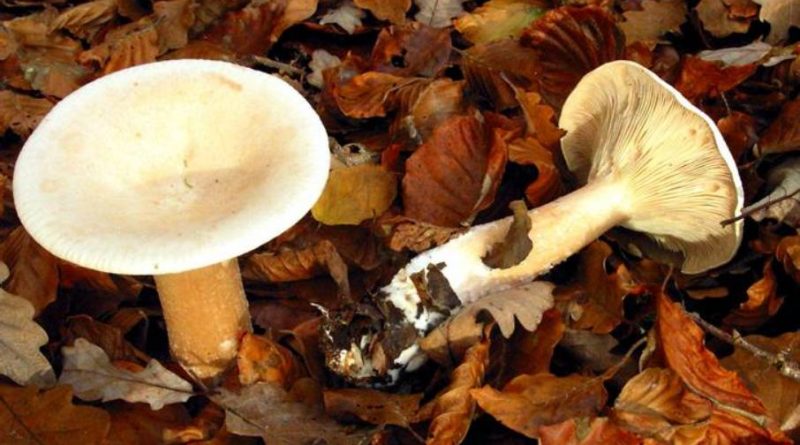Infundibulicybe geotropa
Infundibulicybe geotropa
The trooping funnel or monk’s head (Infundibulicybe geotropa (Bull.) Harmaja, 2003) is a mushroom belonging to the Tricholomataceae family.
Systematics –
From the systematic point of view, the San Martino mushroom belongs to the Eukaryota Domain, Fungi Kingdom, Basidiomycota Division, Basidiomycetes Class, Agaricales Order, Tricholomataceae Family and therefore to the Clitocybe Genus and to the C. geotropa Species. Following a taxonomic revision proposed by the Finnish mycologist Harri Harmaja, the species has taken on the new name of Infundibulicybe geotropa.
The terms are synonymous:
– Agaricus geotropus Bull .;
– Clitocybe gilva var. geotropa (Bull.) P. Kumm. 1871;
– Clitocybe geotropa (Bull.) Quél. 1872;
– Omphalia geotropa (Bull.) Quél. 1886;
– Omphalia geotropa (Bull.) Quél. var. geotropic;
– Clitocybe subinvoluta sensu Lange (2005);
– Clitocybe maxima sensu auct Brit. (2005);
– Agaricus pileolarius Sowerby 1797;
– Agaricus gibbus ß major Fr. 18211.
Etymology –
The term Clitocybe derives from the Greek klitùs = slope and kùbe = head, due to the shape of the hat.
The specific epithet geotropic always derives from the Greek geo = earth and tropèo = I turn, that is, turned towards the ground, due to the vertical bearing of the stem.
Geographic Distribution and Habitat –
The Infundibulicybe geotropa grows in meadows and pastures, among thorny bushes, in groups of numerous specimens, generally in circular formation; this mushroom bears fruit from late summer to late autumn.
Description –
The Infundibulicybe geotropa is characterized by having a hat of 4-12 cm (but can reach 20 cm in diameter) which when young is convex-campanulate or campanulate-umbonate, to then become slightly depressed in the center; fleshy, smooth with a thin and convoluted margin; the color is between yellow-whitish and ocher or hazel and the cuticle is viscous in humid weather. Very small and stocky at the time of birth. The gills are dense, of the same color as the stem and decurrent until they occupy the final part of the stem which is sturdy with a maximum height of around 10 cm, the color is the same as the gills and cap. The flesh of this mushroom is white with a delicate and pleasant flavor. When the mushroom begins to get old its flesh begins to become supple and spongy. The Clitocybe geotropa, especially when young, resembles certain luxuriant forms of Clitocybe gibba (funnel), but especially when adult it has larger dimensions, especially the stem. It can also be confused with Clitocybe maxima, which has a floury odor and similar color, of poor edibility and with a 20-60 cm cap without central umbo, with a short and stocky stem. Clitocybe inornata can also be confusing but this is smaller with a radish smell (soon rancid) of poor edibility and with a flour taste. Finally, another possibility of confusion can be had with Entoloma lividum which is poisonous, with a strong smell of flour, non-decurrent gills and pink in color when ripe.
Cultivation –
The Infundibulicybe geotropa can be cultivated provided that the supply of nutrients it needs and the suitable substrate are respected.
Customs and Traditions –
Infundibulicybe geotropa is a highly sought after edible mushroom of excellent quality. Of this mushroom, both the stem (which must be discarded, however, in the more adult specimens, because it is harder and more fibrous) and the cap are consumed. According to mycologist Giacomo Bresadola, “… it is one of the most exquisite mushrooms and, due to its strong aroma, it can also be cooked in the manner of truffles, using them as a condiment …”.
Preparation Method –
Given the delicacy of its meat, the trooping funnel is used above all alone, sautéed in a pan, or to make seasoning sauces. Alternatively, you can cook in all the other ways that mushrooms are usually prepared in the kitchen. It can also be cooked in soup, and given its strong aroma, it can be preserved in oil or vinegar.
Guido Bissanti
Sources
– Wikipedia, the free encyclopedia.
– Cetto B., 2008. Real mushrooms, Saturnia, Trento.
– Pignatti S., 1982. Flora of Italy, Edagricole, Bologna.
– Conti F., Abbate G., Alessandrini A., Blasi C. (ed.), 2005. An annotated checklist of the Italian vascular flora, Palombi Editore.
Warning: Pharmaceutical applications and alimurgical uses are indicated for informational purposes only, they do not represent in any way a medical prescription; therefore no responsibility is taken for their use for curative, aesthetic or food purposes.


